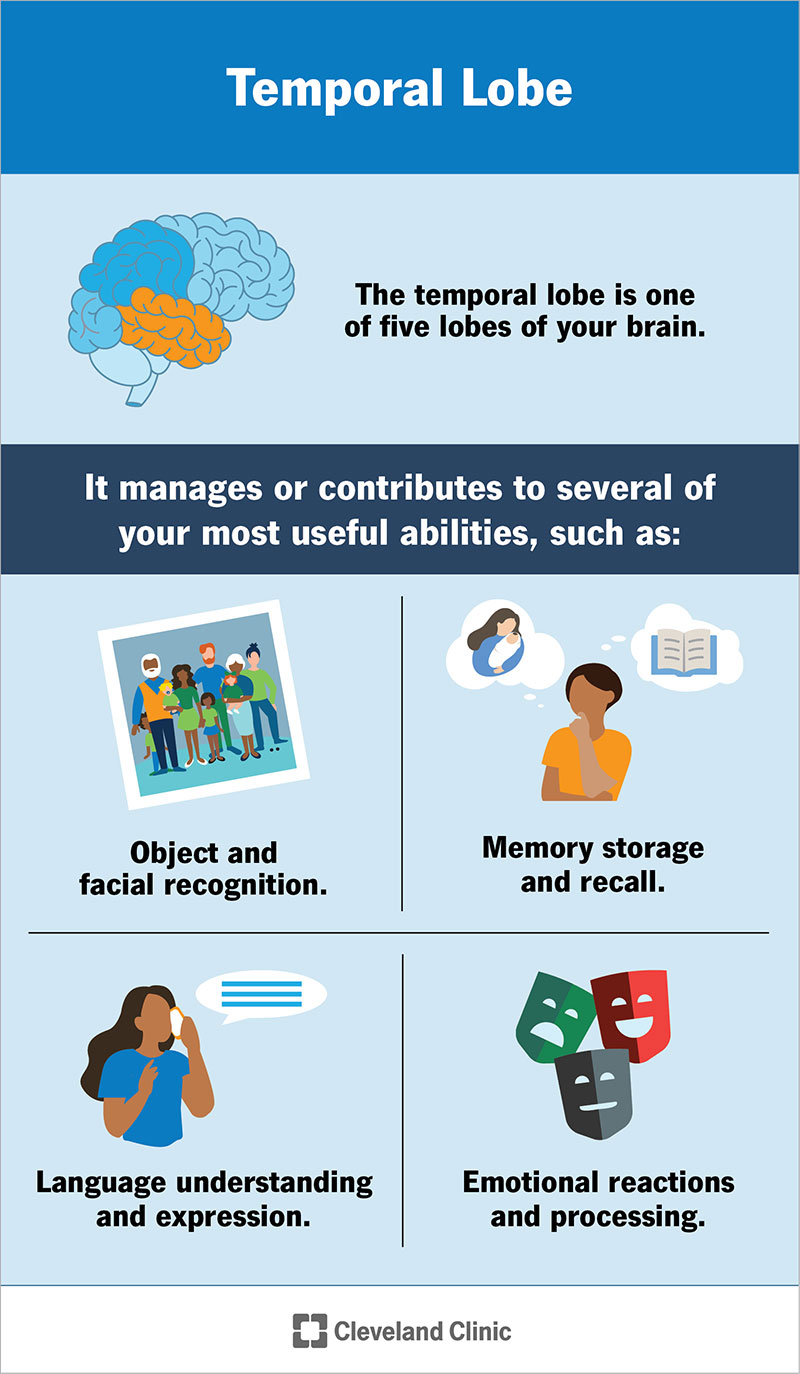The temporal lobe of your brain is a pair of areas on your brain’s left and right sides. These areas, which are inside your skull near your temples and ears, play a role in managing your emotions, processing information from your senses, storing and retrieving memories, and understanding language.
Advertisement
Cleveland Clinic is a non-profit academic medical center. Advertising on our site helps support our mission. We do not endorse non-Cleveland Clinic products or services. Policy

Your temporal lobe is a part of your brain that helps you use your senses to understand and respond to the world around you. It also plays a key role in how you communicate with other people, your ability to access memories, use language and process emotions.
Advertisement
Cleveland Clinic is a non-profit academic medical center. Advertising on our site helps support our mission. We do not endorse non-Cleveland Clinic products or services. Policy
Your temporal lobe contains areas of your brain that manage or contribute to several of your most useful abilities: language, memory and senses. You use these abilities constantly throughout your daily activities. Your temporal lobe contributes to these in the following ways:
All of the above abilities have strong connections. Your senses tell you about the world around you, your memory helps you recognize what’s familiar, your language abilities are part of how you remember and describe what you experience, and emotions are how you feel about it all.
Advertisement
Connections between your senses, memory, language abilities and emotions are all key to your survival. Fear and anxiety are protective emotions (they only become mental health concerns if they happen in ways that are disruptive to your life). Connections between memories and emotions help you use past experiences to recognize danger and avoid it.
Emotions also help with learning. That’s why you feel positive emotions like happiness and pleasure from rewards and good outcomes, and negative emotions like sadness and disappointment from consequences and unwanted outcomes.
Like all lobes of your brain, your temporal lobe has left and right sides. The sides of your temporal lobes are the farthest apart of the brain lobes. Each temporal lobe is right behind the temple area on each side of your head, and the lobe extends backward along the side of your brain to a point just behind your ears.
Most of your brain tissue, including your temporal lobe, is a light pinkish-gray when it has blood circulating in it. Without circulating blood, brain tissue has a more grayish color.
Your temporal lobe is the second-largest of your brain’s five lobes. It makes up about 20% of the cerebral cortex of your brain. The word “cortex” comes from Latin and means “tree bark.” The cortex is the wrinkly-textured outer surface of your brain, and its average thickness is about 2.5 millimeters.
Your temporal lobe consists of the same kinds of specialized cells found throughout your brain and nervous system. The basic cell types are:
The temporal lobe contains a few noteworthy areas:
Advertisement
Virtually any brain-related condition or illness can affect your temporal lobe. Some conditions, especially mental health-related conditions, may affect it very specifically. Examples include:
There are dozens (or more) of possible symptoms that can result from damage or disruptions in your temporal lobe. Two reasons why there are so many possible symptoms include:
Advertisement
While the full list is extensive, some symptoms are more common or could indicate a dangerous issue. These include:
There are many ways healthcare providers can check the health of or look for problems in your temporal lobe. These include diagnostic tests, lab tests, imaging scans and more. Common tests include:
Advertisement
Because so many conditions can affect your temporal lobe, the treatments can vary widely. Your healthcare provider is the best person to tell you about the possible treatments and what they recommend.
There are a number of things you can do to maintain how well your temporal lobe works, including:
There are many other ways to help maintain your brain health overall. While many brain conditions aren’t preventable, you may be able to delay or reduce the severity of some conditions. Some things you can do for your brain health include:
Your brain’s temporal lobe is a key part of understanding the world around you, communicating with others, processing feelings and emotions, and storing certain types of memories (including memories about facts like in this article). Taking care of your brain health, especially relating to your temporal lobe, is important. That way, you improve the odds that your temporal lobe will continue to help you appreciate the world around you, enjoy time with others and remember precious moments throughout your lifetime.
If you have a neurological condition, you want expert advice. At Cleveland Clinic, we’ll work to create a treatment plan that’s right for you.

Last reviewed on 01/08/2023.
Learn more about the Health Library and our editorial process.